Maintaining the appropriate levels of transmission fluid in your vehicle is crucial because it ensures everything functions optimally and seamlessly. As such, deciding whether or not to replace it should not be optional.
Need tools for your project? Toolbox, a tool rental marketplace, might be worth a look.
However, how often you should perform this service varies by the vehicle and manufacturer. It also depends on whether your vehicle’s transmission is manual or automatic.
This article will show you:
- How often to change transmission fluid for automatic and manual tranmsission
- How to change the fluid
- Transmission fluid change cost
Read on!
How often to change transmission fluid?
The requirements for changing transmission fluid maintenance vary with the cars because every vehicle is different. You can either check your transmission fluid or the owner’s manual to determine when you should perform the service. It’s best to consider factors such as the car brand, whether the vehicle is heavy-duty or light-duty, where you live, driving habits, and more. Read further to find out more!
How often to change manual transmission fluid?

Fluid contamination is often the problem with manual transmission, not fluid degradation. The contamination occurs as the gears and bearings (synchronizers) in the transmission wear out. With the metal particles floating in the fluid, it won’t lubricate like clean oil. When this happens, you should change the lubricant to avoid shortening your transmission system’s life.
Most manufacturers recommend changing the fluid in their manual transmission system every 30,000 to 60,000 miles. However, if you are continually putting the transmission under stressful conditions, the oil should be changed sooner, at every 15,000 miles.
How often to change automatic transmission fluid?

Fluid in automatic transmission systems often breaks down and degrades with ease because more heat is generated. It also experiences contamination. The recommended service interval in automatic transmissions/transaxles is between 30,000 to 100,000 miles or 30 months. You can determine your car’s specifics by checking your owner’s manual or service manual.
Other considerations
How often to change the transmission fluid is not dependent on the transmission type only. Some other factors to consider are:
Your type of vehicle
While there are vehicles that come with a dipstick to help you check if you need to change the fluid, many cars are not equipped with the feature today. In this situation, looking into the maintenance schedule may help you know if the transmission fluid needs changing.
For example, the 2017 Jeep Wrangler’s maintenance schedule says if you are using the vehicle for frequent trailer towing, fleet, taxi, or police, change the transmission fluid at 60,000 miles. However, if you are not using the car for any of these activities, perform the service at 120,000 miles. It means the service interval for this vehicle is between 60,000 to 120,000 miles.
What if the vehicle does not have a transmission dipstick and the fluid change is not mentioned in the maintenance schedule? Does it mean you don’t have to change the fluid for life? Mechanical wear is not eliminated even though there has been an improvement in transmission technology and fluid quality. So, it means you will need to change the lubricant sooner or later.
For instance, transmission fluid change for normal driving conditions was not included in the 2018 Toyota Camry’s maintenance schedule. The best way to go is to ask your dealer’s opinion about changing the transmission fluid. However, Toyota recommends that you inspect automatic transmission fluid every 36 months or 30,000 miles and replace it every 72 months or 60,000 miles.
Furthermore, in light-duty vehicles, you should change the fluid every 1,300 hours or 30,000 to 40,000 miles. However, for heavy-duty to severe duty cars, you should perform the service every 825 hours or 35,000 miles .
Your driving habit
You may not need to change the transmission fluid often if you drive your car under normal conditions. However, suppose you always put the vehicle through conditions other than ordinary, such as continually accelerating faster and always driving at low speed for an extended period. In that case, you might have to change the fluid frequently. Check the fluid regularly and ensure that you change it if the color is different from the traditional bright red.
Where you live
The fluid’s quality can experience deterioration through everyday usage. This can happen quickly if you are continually driving on rough terrains and harsh weather. For example, if the weather is cold, the transmission system’s parts get shorter. This results in the faster wearing of the components and makes the fluid lose its lubricating power quickly. So, if you drive your car on mountain terrains or other rough or severe conditions too often, it is advisable to change the transmission fluid at regular intervals.
4 Reasons you should change your transmission fluid more often
Your car’s transmission has a lot of moving parts that need to move and work freely. The transmission fluid acts as a lubricant with slippery substances to ensure the components run well without any issues. The oil also serves as a viscous fluid and coolant, assuring that the power is transmitted from the engine to the transmission system efficiently.
Regularly changing your vehicle’s transmission fluid will make your car run well for a longer time. The benefits of performing this service include:
Saving fuel
Increasing the fuel economy of your vehicle is a popular idea. Do you know that one of the great ways to improve your car’s fuel economy is by regularly changing the transmission oil? When you change the oil and everything is in proper condition, the transmission system will work smoother. It means the engine will run graciously, ensuring that you don’t have to worry about gas running out faster.
Avoiding putrid odor
When the transmission fluid gets old, the filter can get clogged, and your car’s engine can start working harder than normal. This can make your vehicle emit an unpleasant putrid odor, which may lead to cough, nauseous feel, headache, and other health problems. Changing the oil in your car’s transmission system can help you avoid putrid odor.
Avoiding overheating engine
Do you know that an overheating transmission, mostly in automatic systems, can result in an overheating engine? With your transmission system in perfect condition, it is expected to work flawlessly. But if it fails to work at the best level, the system can experience excessive slippage, friction, and wear, creating a lot of heat. However, changing the transmission fluid regularly can help the system work under good conditions that can avoid overheating car’s engine.
Preventing car’s transmission damage
The transmission system is a delicate and complicated part of your vehicle. Serious issues like delay in shifting, grinding gears and more often come up when you do not do proper maintenance. However, you can avoid the troubles by changing the transmission fluid at the appropriate time.
Suppose you don’t change the transmission fluid, the system’s fluid can get old and stop serving as an effective lubricant. It may also stop dispersing heat well, resulting in tear and wear of the clutches, especially in manual vehicles and other transmission systems.
When the transmission fluid needs to be changed?
One of the most common ways to know if your transmission fluid needs to be changed is using the dipstick if your car has one. Before you locate and remove the transmission dipstick, confirm if your car’s engine should be running or off, and if the gear selector should be moved into each gear before checking the fluid. Check the owner’s manual to know the condition that should be fulfilled before removing the dipstick.
After you have met the right condition pertaining to your car model, remove the dipstick and wipe off the fluid on it with a tissue paper or clean rag. Reinsert the dipstick and remove it again to check the oil’s color.
Transmission fluid color: What does it mean?
With the transmission fluid color, you can gather plenty of information regarding your car’s transmission system condition. To determine the transmission fluid’s quality, closely observe the dipstick’s tip and assess the color. Here are the transmission fluid color explanations and the recommended procedures for each of them.
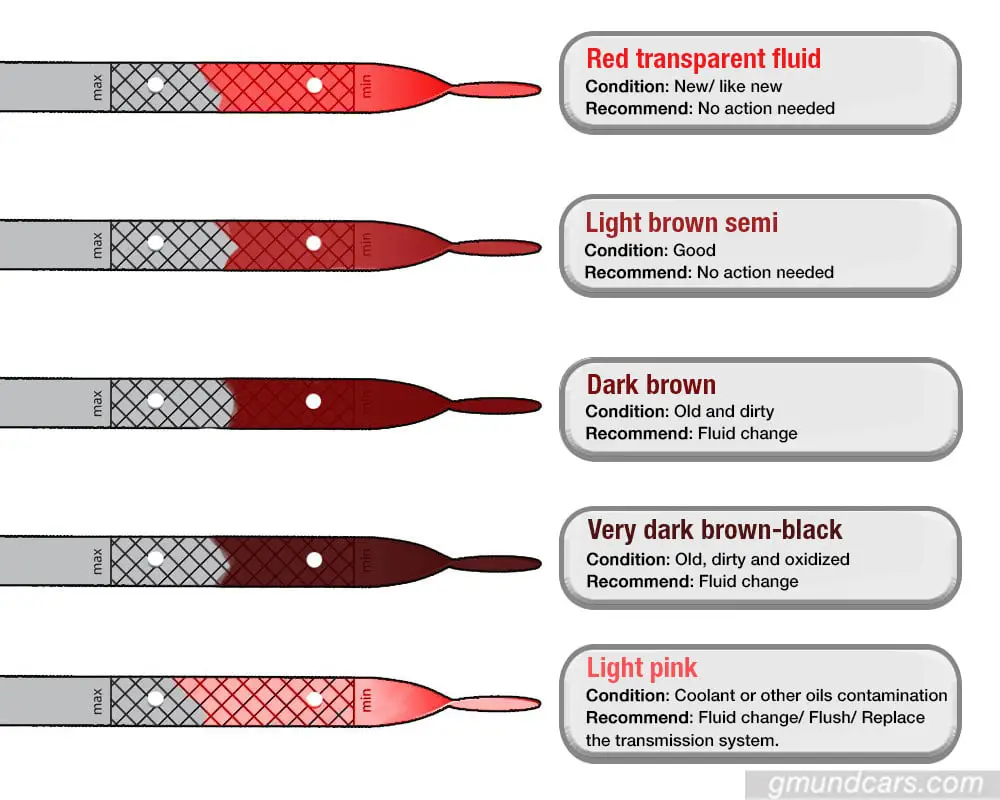
- Red
Condition: Red transparent transmission fluids indicate new or excellent condition. If your car’s transmission fluid is red, maintain its condition and secure the level doesn’t go below the minimum amount.
Recommend: Regularly check the transmission fluid to strengthen your vehicle’s performance.
- Light brown
Condition: With light brown color, your transmission fluid is mostly in good condition.
Recommend: Follow the car’s manual for the fluid replacement intervals and keep an eye out for leakages.
- Dark brown
Condition: Transmission fluids with a dark brown color signify old and tarnished fluid quality. When your car’s transmission fluid is in bad shape, it would not be able to provide sufficient lubrication.
Recommend: Since inadequate lubrication generates excessive heat, make sure to flush out the remaining soiled fluids and replace them.
- Black
Condition: A black-colored transmission fluid means that the transmission system has already acquired damages. The liquid is black as a result of problems within the transmission system.
Recommend: If you encounter black transmission fluids, perform a transmission flush and a fluid change.
- Light pink
Condition: When water or engine coolants contaminate the transmission fluids, they ruin the seals and friction clutch plates. If these fluids break into the transmission, they cause failure in the entire transmission system.
Recommend:The only way to remedy this problem is to take your car to a specialist and replace the whole transmission.
However, whether your vehicle comes with a transmission fluid stick or not, there are some other signs to help you know when to change the fluid.
Others signs
Difficulty in shifting
If there is too much sludge or dirt in your vehicle’s transmission system, the fluid will not flow smoothly. This can make the gear respond to change too late or quickly while driving. You may even find it challenging to shift from one gear to another in manual transmission cars. When you start experiencing delayed or rough shifting, it means it is time to change the transmission fluid.
Noise when shifting gears
If you notice that your vehicle is making a strange noise or transmission grinding, it may be a sign that the fluid needs to be changed.
Burning odor
Even though a sweet, burning smell is often related to radiator coolant issues, it can also be related to your transmission oil. In some situations, the coolant can leak and mix with the transmission system fluid. So, ensure that you or your mechanic properly inspects any unusual odor.
Slipping transmission
Even though failed torque converter, faulty transmission solenoid, and bands, gears, and clutch wears can make your transmission move out of position, low or contaminated transmission oil is the most common cause. The transmission slipping symptoms are excessively high RPM, harsh response to gear shifting, delay in acceleration, strange noises, and more. So, if your transmission slips in and out of gear, the system needs some inspection, and you may need to change the fluid.
Warning light
Newer cars often come with lights that indicate that the transmission temperature is too high. Pay attention to this indicator.
If your engine revs or roars when going around corners or accelerating, you may need to check the transmission fluid.
How to change transmission fluid
Consideration before changing transmission fluid
Double check if your vehicle comes with a transmission fluid dipstick or NOT.
- If your car has one, follow my guide below.
- If your car DOES NOT come with that feature, checking and changing the fluid on your own is not recommended for a DIYer. Cars with sealed transmission require a shop lift, strict adherence to procedure, and specialized tools for adding new oil. It is advised to take your vehicle to a service shop.
Preparation
You will need the right equipment to get this task done correctly:
- Floor jack
- Flat pan or container
- Socket set and rachet
- Gloves and safety glasses
- Funnel
- Rags
- New filter
- New gasket
- Transmission fluid
- Cardboard or newspaper
Estimated time needed: This operation can take you 30 to 60 minutes to complete.
Step by step guide
Note: The steps guide for changing transmission fluid for manual and automatic vehicles are the same. However, the types of transmission fluid used will be different.
Step 1: Jack up your car
Park your car on a flat, even surface and jack it up to create enough space under the vehicle. Ensure you use the manufacturer’s lift point and acceptable bracings like support chucks and stands to ensure safety.
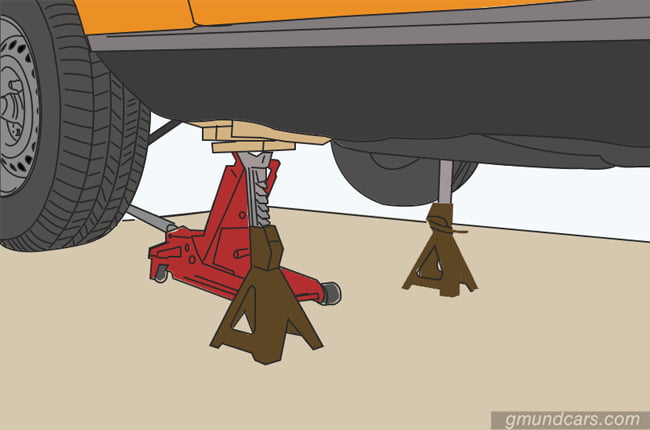
Step 2: Locate the transmission fluid pan
You can locate the transmission fluid pan by crawling underneath the vehicle because it is often found at the transmission’s bottom. The transmission of most rear-wheeled cars hangs under the center console area from front to rear, while front-wheeled vehicles are located under the engine bay from left to right.
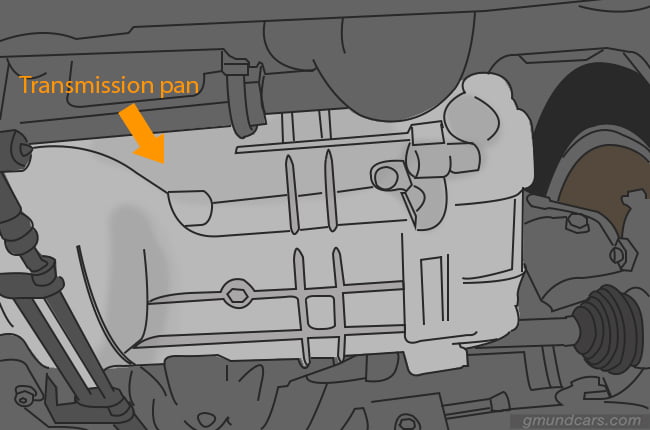
Step 3: Place a flat pan or container underneath
You will need a container or pan that can be as wide as the transmission pan to collect the old fluid because the operation can be very messy, especially if the system lacks a drain plug. Lay down the cardboard or newspaper, and put the collection pan on it, ensuring that it is placed directly under the drain hole.
Step 4: Drain the old fluid
Make sure the transmission is at normal operating temperature before draining the fluid. Check if your transmission has a drain plug, unscrew it to start draining the old fluid into the collection container.
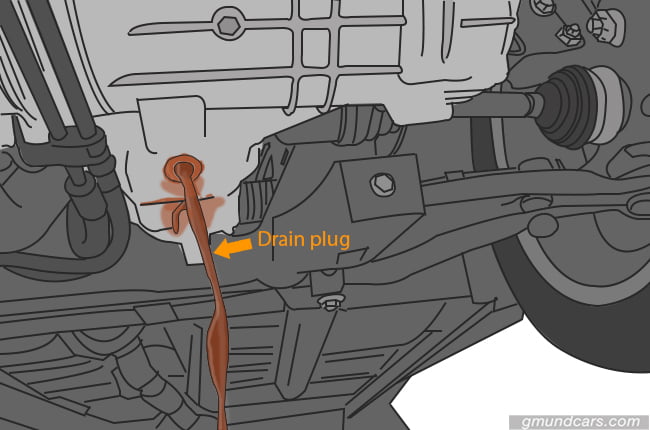
If your system does not have a drain plug, you will have to remove the transmission fluid pan to drain it. The fluid pan often has 6 or 8 bolts. Gradually loosen some of the bolts from one side until the pan tilts and the oil starts to drain into the collection container. Once it stopped draining, unscrew the other bolts, lower the pan carefully, and drain the remaining oil in the pan.
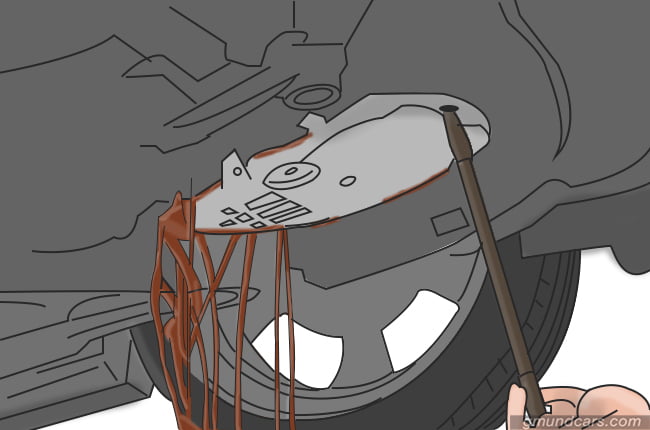
Step 5: Examine the old fluid
After draining the fluid out, examine it. Typically, it is normal for you to see metal shavings resulting from the gear’s wear and tear. Also, inspect the pan for internal damage signs, remove the metal shavings, and use a solvent to clean it. However, with odd-shaped or larger chunks are not normal, you may need to contact a certified mechanic to help you check if your vehicle’s transmission system needs immediate attention.
Step 6: Replace the transmission pan gasket and filter
After draining all the oil, use a screwdriver to gently break the gasket seal and clean the transmission housing and pan’s surface. Also, a filter is attached to the transmission with an O-ring seal, clips, or bolts. Remove the transmission filter, which can also contain fluids, allow it to drain in the pan, and trash it.
Get the new transmission filter and install it by ensuring that the O-ring seal seats in the appropriate position. Also, use an oil-soluble grease to attach the new gasket to the pan.
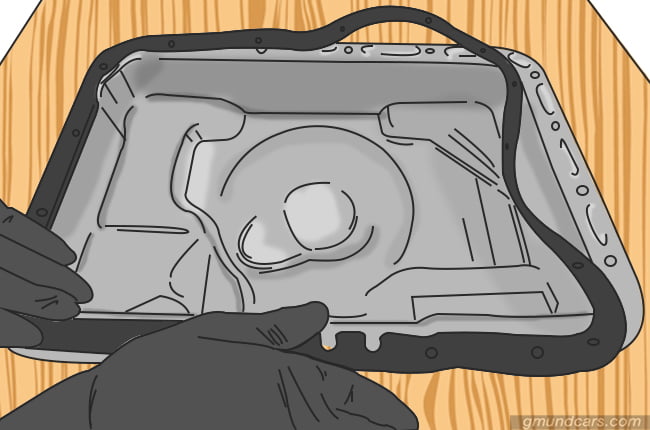
Step 7: Tighten the transmission pan bolts after replacing the new gasket and filter
Use your hand to screw the bolts back to their normal position, and then use a rachet (hand or electric) to tighten them starting from the center. Avoid over-tightening the bolts.
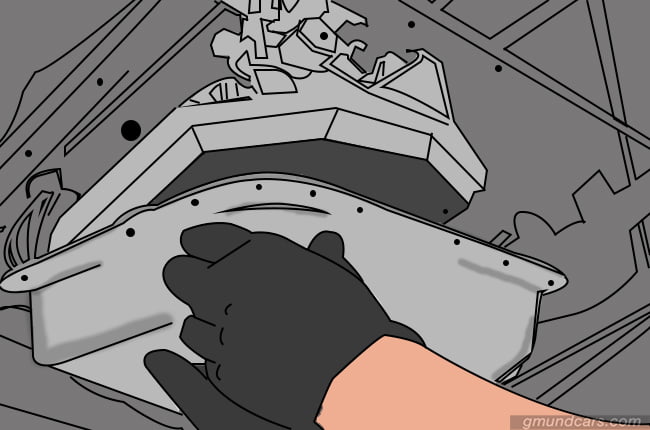
Step 8: Add the new fluid
Once you have replaced the transmission pan and you are sure that everything is in perfect condition, move out from under the car. Also, remove the collection pan and other things you used while performing the operation. Then take your car down from the jack stand. By measuring the old drained fluid, you can know how much new fluid your vehicle needs.
Open the hood, locate the transmission fluid dipstick. Pull it out
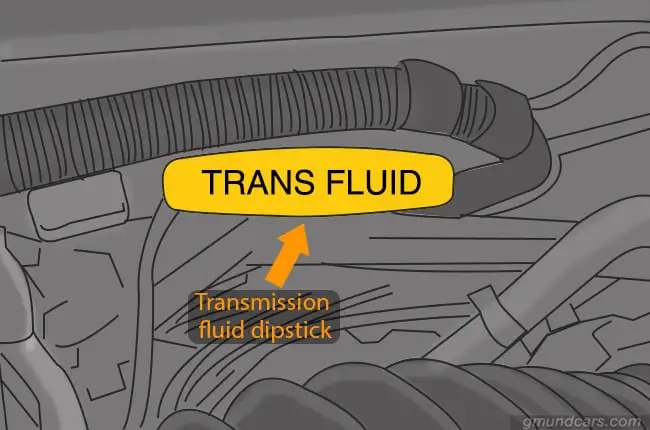
Insert a funnel, and fill the system with new transmission fluid. Remember, the quality and type of oil to use can vary with manufacturer and vehicle. So, ensure to check your car owner’s manual.

Step 9: Reinstall the dipstick and close the hood
After adding the appropriate fluid, remove the funnel, put the transmission fluid dipstick back to its port, and close the hood. Then start your car’s engine, make sure it runs for a few minutes and shut it off. Check underneath the vehicle for any leaks and if there are no leaks, confirm the fluid level by reinspecting the dipstick. Add more fluid if the level is low. Repeat this process until the oil is at the right level.
Transmission fluid change cost
The cost of transmission fluid change depends on the independent mechanic, service center, or dealer you take your car to. The price is likely to range between $80 to $250 and even up to more than $500. However, if you are willing to do it yourself, the cost should fall between $50 to $100. Let’s see the average cost when you do it yourself is as below:
| Average cost | |
|---|---|
| New fluid | $8 to $20/ quart (you will spend $40 to $100 on fluid) |
| New filter | $15 to $30 |
| New pan gasket | $15 to $50 |
Let’s look at the table below for the reference of the transmission fluid change cost of some shops:
| Service shop | Fluid change cost | Warranty |
|---|---|---|
| Your Mechanic | $170 – $420 | 12 months |
| Midas | $159 – $352 | 12 months |
| Mr. Tire | $160 – $410 | 12 months |
| NAPA | $144 – $550 | 24 months |
Some other factors that affect the transmission fluid cost are:
- The vehicle’s make and model (it can cost more to change the transmission fluid of high-end brands). For example, you can spend around $600 upward to change a paddle-shift Lamborghini’s transmission fluid.
- Quantity of transmission fluid needed to fill your vehicle.
- The type of transmission fluid your car uses.
Final words
Undoubtedly, you will get a few different numbers when asking the question: “How often to change transmission fluid?”. There are many factors affecting this process as I mentioned earlier. On the one hand, following your vehicle manufacturer’s recommendation is one way to go.
Changing the fluid more often won’t harm your transmission. Instead, it will keep it at an optimum performance level. So pay attention to the symptoms that indicate your transmission system needs a fluid change to avoid any mishaps that may happen.
FAQs
1. Can changing transmission fluid be bad?
I am sure to tell you that changing transmission is a GOOD step to follow. If we do not change it as schedule, the oil gets thicker and becomes less slippery as it gets old. Sometimes, the extra friction is what makes the clutch keep working correctly. When you add new fluid to the transmission, the car might refuse to shift out of gear or start to slip. It is crucial to change the transmission fluid of your car periodically
2. How to know if my transmission is overfilled?
The proper quantity of fluid keeps a constant pressure level inside the transmission system. However, the pressure builds up when too much oil is added, resulting in the lubricant’s contamination. Overfilled transmission can also cause leakage of fluid from the gearbox, transmission failure, overheating of the system, and faster transmission system wear. The transmission system’s symptoms of too much fluid also include a high level on the dipstick, problems in shifting, and noise from the transmission.
3. How much transmission fluid do I put in my car?
The amount of fluid that goes into each component of your vehicle is specified in your owner’s manual. However, some vehicle manufacturers do not specify the amount of fluid needed for your car. In this case, you can still fill your vehicle with the correct quantity of oil. Drain the oil in the transmission pan and measure it to know the amount of fluid you need to put in your vehicle.
4. Is it risky to change the transmission fluid in high-mileage cars?
Changing the transmission fluid in high-mileage cars is NOT advisable. When you perform this service for a high-mileage car, a lot can go wrong. The product of wear may contaminate the oil if it has never been changed. These products can temporarily seal various O-rings and pistons and start making the transmission shift differently or slip. Ensure that the fluid is first-rate and your transmission is running fine before you do it.